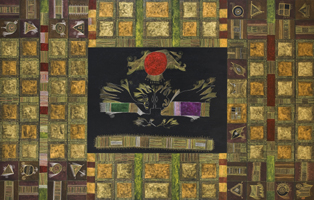Search for:
ARTISTIC
CONTRIBUTIONS
> Visual > Central
Asian
Khosro Berahmandi | Born in Iran in the late fifties,
he was raised in Tehran when the Shah was in power. In his early
twenties, during his technical studies at university, he let
himself be carried away by the overwhelming sweep of the Iranian
revolution and the dream of living in a free Iran. His dream
was soon destroyed by the reality of the Revolution. Deeply affected
by the loss of his close friends, he left his native country
in 1982.
Khosro completed his first
painting in his early twenties on the cover of Dostoyevsky's
Crime and Punishment while he still lived in Iran. It would be
another two years before Khosro once again picked up paint brushes,
shortly after he arrived in Canada as a political refugee following
Iran's Islamic Revolution. He sought an outlet to express the
break he felt after leaving Iran, as he entered a space that
was quite different from anything he had previously experienced.
He discovered painting gave him a new language to communicate
with. Khosro soon enrolled at the University of Western Ontario,
studying with Paterson Ewen. After a short trip to Montréal,
he decided that he needed to live in this city that was buzzing
with the excitement of an active arts community. Khosro completed
his bachelor's degree at Concordia University. His fervour for
visual arts next took him to the University of Paris where he
gained a master's degree in Plastic Arts. The charm of Montréal
had not left him and he returned to the city in 1995.
 Khosro's early visual language was
based on an expressionistic cry that attempted to portray human
despair. Based on his personal experiences, he produced a body
of dark abstract expressionistic work that he then desperately
destroyed in 1992.
Khosro's early visual language was
based on an expressionistic cry that attempted to portray human
despair. Based on his personal experiences, he produced a body
of dark abstract expressionistic work that he then desperately
destroyed in 1992.
After his studies in Paris
and his return to Montréal, he turned his attention towards
a more fantasy-based language that would replace the despair
and horrific human experience with imagination and dream. He
concentrated his attention on Iranian literature and mythology
while looking for inspiration in the culture of miniature visionaries
of the Indo-Iranian experience of the 11th to 16th centuries.
Since the mid-1990s, he has
created a large stylistic body of work that not only reflects
on a long ago past but projects the freshness of its ideas. Khosro's
work has been shown in over 30 exhibitions throughout Canada,
the United States and Europe.
www.khosro.info
<<
top
 The project was made
possible with the support of the
The project was made
possible with the support of the
Department
of Canadian Heritage through the Canadian Culture Online Strategy
The Acrobat Reader
is available free from 